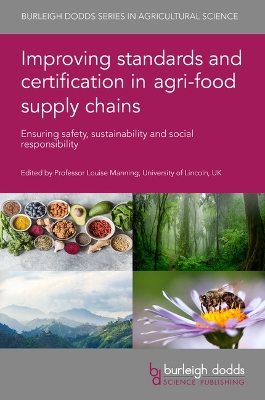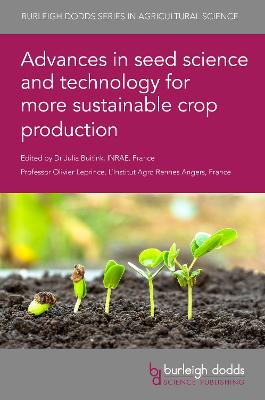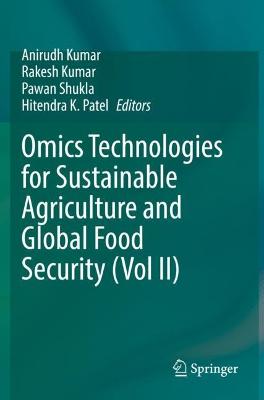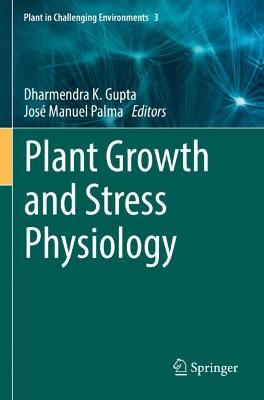Advances in Plant Phenotyping for More Sustainable Crop Production
 portes grátis
portes grátis
Advances in Plant Phenotyping for More Sustainable Crop Production
Schurr, Prof Ulrich; Pieruschka, Dr Roland; Walter, Dr Achim; Rehman, Dr Tanzeel U.; Acevedo, Dr Liana; Pinera-Chavez, Dr Francisco J.; Jin, Dr Jian; Pinto, Dr Francisco; Reynolds, Dr Matthew; Rivera-Amado, Dr Carolina
Burleigh Dodds Science Publishing Limited
06/2022
404
Dura
Inglês
9781786768568
15 a 20 dias
1.Origins and drivers of crop phenotyping: Roland Pieruschka and Ulrich Schurr, Institute for Bio- and Geosciences (IBG), IBG-2: Plant Sciences, Forschungszentrum Juelich, Germany;
2.The evolution of trait selection in breeding: from seeing to remote sensing: Matthew Reynolds, Francisco Pinto, Liana Acevedo, Francisco J. Pinera-Chavez, and Carolina Rivera-Amado, International Maize and Wheat Improvement Center (CIMMYT), Mexico;
Part 2 Sensor types
3.Advances in optical analysis for crop phenotyping: Jian Jin and Tanzeel U. Rehman, Purdue University, USA; and Qin Zhang, Washington State University, USA;
4.Advances in the use of thermography in crop phenotyping: David M. Deery, CSIRO Agriculture and Food, Australia;
5.Advances in the use of X-ray computed tomography in crop phenotyping: Stefan Gerth, Norman Uhlmann and Michael Salamon, Fraunhofer EZRT, Germany;
Part 3 Carrier/delivery systems
6.Field robots for plant phenotyping: Rick van de Zedde, Wageningen University and Research, The Netherlands; and Lili Yao, Visiting Researcher - Wageningen University and Research, The Netherlands;
7.Advances in the use of aerial systems/UAVs for crop phenotyping as examples for lean, low-cost, high-throughput field crop phenotyping systems: Helge Aasen, Institute of Agricultural Sciences, ETH Zurich and Remote Sensing Team, Division of Agroecology and Environment, Agroscope, Switzerland; and Lukas Roth, Institute of Agricultural Sciences, ETH Zurich, Switzerland;
Part 4 Data analysis
8.Meeting computer vision and machine learning challenges in crop phenotyping: Hanno Scharr, Institute of Bio- and Geosciences: Plant Sciences (IBG-2) and Institute for Advanced Simulation: Data Analytics and Machine Learning (IAS-8), Forschungszentrum Juelich, Germany; and Sotirios A. Tsaftaris, The University of Edinburgh and Alan Turing Institute, UK;
9.Digital phenotyping and genotype-to-phenotype (G2P) models to predict complex traits in cereal crops: Nicolas Virlet, Rothamsted Research, UK; Danilo H. Lyra, Biometrics and Breeding Research, BASF, Belgium; and Malcolm J. Hawkesford, Rothamsted Research, UK;
10.The role of crop growth models in crop improvement: integrating phenomics, envirotyping and genomic prediction: Jana Kholova, International Crops Research Institute for the Semi-Arid Tropics (ICRISAT), India; Amir Hajjarpoor, UMR DIADE, Universite de Montpellier, Institut de Recherche pour le Developpement (IRD), France; Vincent Garin, International Crops Research Institute for the Semi-Arid Tropics (ICRISAT), Mali; William Nelson, Gottingen University, Germany; Madina Diacoumba, International Crops Research Institute for the Semi-Arid Tropics (ICRISAT), Mali; Carlos D. Messina, Pioneer Hi-Bred International, USA; Graeme L. Hammer, Queensland Alliance for Agriculture and Food Innovation - The University of Queensland, Australia; Yunbi Xu, Chinese Academy of Agricultural Sciences, China and International Maize and Wheat Improvement Center (CIMMYT), Mexico; Milan O. Urban, International Center for Tropical Agriculture (CIAT), Colombia; and Jan Jarolimek, Czech University of Life Sciences (CZU), Czech Republic;
Part 5 Case studies
11.Using phenotyping techniques to analyse crop functionality and photosynthesis: Eva Rosenqvist, University of Copenhagen, Denmark;
12.Using phenotyping techniques to predict and model grain yield: translating phenotyping into genetic gain: Thomas Vatter and Jose L. Araus, University of Barcelona and AGROTECNIO (Center for Research in Agrotechnology), Spain;
13.Automated assessment of plant diseases and traits by sensors: how can digital technologies support smart farming and plant breeding?: Anne-Katrin Mahlein, Institute of Sugar Beet Research, Germany; Jan Behmann, Bayer Crop Science, Germany; David Bohnenkamp, BASF Digital Farming GmbH, Germany; Rene H. J. Heim, UAV Research Centre (URC), Ghent University, Belgium; and Sebastian Streit and Stefan Paulus, Institute of Sugar Beet Research, Germany;
1.Origins and drivers of crop phenotyping: Roland Pieruschka and Ulrich Schurr, Institute for Bio- and Geosciences (IBG), IBG-2: Plant Sciences, Forschungszentrum Juelich, Germany;
2.The evolution of trait selection in breeding: from seeing to remote sensing: Matthew Reynolds, Francisco Pinto, Liana Acevedo, Francisco J. Pinera-Chavez, and Carolina Rivera-Amado, International Maize and Wheat Improvement Center (CIMMYT), Mexico;
Part 2 Sensor types
3.Advances in optical analysis for crop phenotyping: Jian Jin and Tanzeel U. Rehman, Purdue University, USA; and Qin Zhang, Washington State University, USA;
4.Advances in the use of thermography in crop phenotyping: David M. Deery, CSIRO Agriculture and Food, Australia;
5.Advances in the use of X-ray computed tomography in crop phenotyping: Stefan Gerth, Norman Uhlmann and Michael Salamon, Fraunhofer EZRT, Germany;
Part 3 Carrier/delivery systems
6.Field robots for plant phenotyping: Rick van de Zedde, Wageningen University and Research, The Netherlands; and Lili Yao, Visiting Researcher - Wageningen University and Research, The Netherlands;
7.Advances in the use of aerial systems/UAVs for crop phenotyping as examples for lean, low-cost, high-throughput field crop phenotyping systems: Helge Aasen, Institute of Agricultural Sciences, ETH Zurich and Remote Sensing Team, Division of Agroecology and Environment, Agroscope, Switzerland; and Lukas Roth, Institute of Agricultural Sciences, ETH Zurich, Switzerland;
Part 4 Data analysis
8.Meeting computer vision and machine learning challenges in crop phenotyping: Hanno Scharr, Institute of Bio- and Geosciences: Plant Sciences (IBG-2) and Institute for Advanced Simulation: Data Analytics and Machine Learning (IAS-8), Forschungszentrum Juelich, Germany; and Sotirios A. Tsaftaris, The University of Edinburgh and Alan Turing Institute, UK;
9.Digital phenotyping and genotype-to-phenotype (G2P) models to predict complex traits in cereal crops: Nicolas Virlet, Rothamsted Research, UK; Danilo H. Lyra, Biometrics and Breeding Research, BASF, Belgium; and Malcolm J. Hawkesford, Rothamsted Research, UK;
10.The role of crop growth models in crop improvement: integrating phenomics, envirotyping and genomic prediction: Jana Kholova, International Crops Research Institute for the Semi-Arid Tropics (ICRISAT), India; Amir Hajjarpoor, UMR DIADE, Universite de Montpellier, Institut de Recherche pour le Developpement (IRD), France; Vincent Garin, International Crops Research Institute for the Semi-Arid Tropics (ICRISAT), Mali; William Nelson, Gottingen University, Germany; Madina Diacoumba, International Crops Research Institute for the Semi-Arid Tropics (ICRISAT), Mali; Carlos D. Messina, Pioneer Hi-Bred International, USA; Graeme L. Hammer, Queensland Alliance for Agriculture and Food Innovation - The University of Queensland, Australia; Yunbi Xu, Chinese Academy of Agricultural Sciences, China and International Maize and Wheat Improvement Center (CIMMYT), Mexico; Milan O. Urban, International Center for Tropical Agriculture (CIAT), Colombia; and Jan Jarolimek, Czech University of Life Sciences (CZU), Czech Republic;
Part 5 Case studies
11.Using phenotyping techniques to analyse crop functionality and photosynthesis: Eva Rosenqvist, University of Copenhagen, Denmark;
12.Using phenotyping techniques to predict and model grain yield: translating phenotyping into genetic gain: Thomas Vatter and Jose L. Araus, University of Barcelona and AGROTECNIO (Center for Research in Agrotechnology), Spain;
13.Automated assessment of plant diseases and traits by sensors: how can digital technologies support smart farming and plant breeding?: Anne-Katrin Mahlein, Institute of Sugar Beet Research, Germany; Jan Behmann, Bayer Crop Science, Germany; David Bohnenkamp, BASF Digital Farming GmbH, Germany; Rene H. J. Heim, UAV Research Centre (URC), Ghent University, Belgium; and Sebastian Streit and Stefan Paulus, Institute of Sugar Beet Research, Germany;







